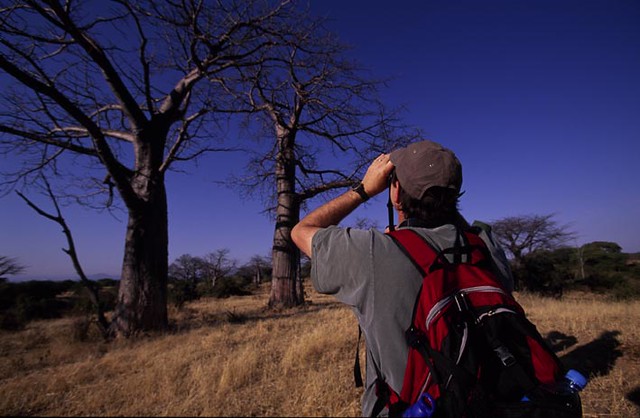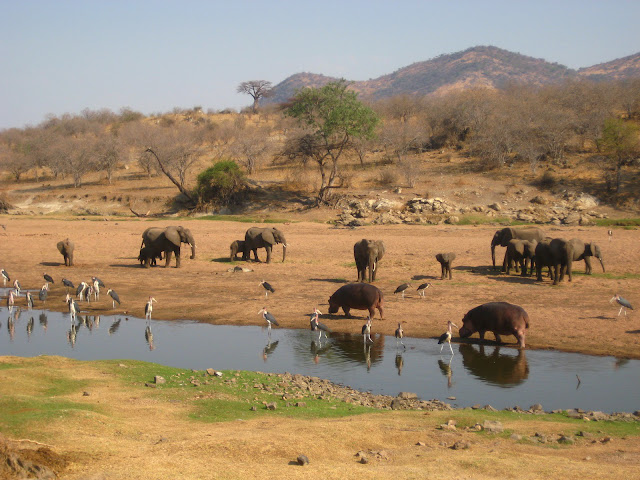Ruaha is now Tanzania’s largest national park and offers excellent wildlife viewing. It is particularly good for spotting predators, including very large prides of lion and the endangered wild dog. Elephants and a big variety of antelope species are another big draw to the park. It also has outstanding wilderness appeal, with limited exclusive, luxury camps available.
Ruaha National Park Highlights
It is a remote bastion of spectacular wilderness, undisturbed wildlife, and breath-taking scenery and also combines well with the Selous Game Reserve. A major attraction here is the fact that it is one of the least visited parks offering a personal and private safari experience.
Ruaha offers one of the largest populations of elephant in any African park, and the vast open areas are teeming with antelope and buffalo followed by the predators especially lion and potentially leopard, as well as African hunting dog and numerous giraffe and zebra.
Historically, Ruaha was not a sought after destination for tourists due to the arid environment and the tsetse fly population; however, nowadays, the tsetse flies are under control and wildlife abounds. The best part is that it is still an uncrowded and undiscovered reserve.
Wildlife
All big cats are regularly seen, and wild dog are the star attraction. They are especially easy to find when denning. Several antelope species that are rare or absent in northern Tanzania, such as greater and lesser kudu, roan and sable antelope, are often encountered.
More about Ruaha's wildlife
Scenery
The main feature of the park is the Great Ruaha River, which attracts loads of animals in the Dry season. The dominant vegetation is brachystegia (miombo) woodland, and some areas are dotted with the impressive baobab tree.
Weather & Climate
Due to Ruaha being near the equator, temperatures don’t change much from month to month. The area is at its coolest during the Dry season (May to October), which doesn’t say much when the average afternoon temperature is around 27°C/81°F. The Wet season (November to April) piles on the heat and the humidity, with the rainfall at its heaviest early in this period.
Mystery Gorilla Safaris Says
Ruaha National Park has an incredibly diverse landscape. One of the most outstanding geographical features is the Great Ruaha River, which is the life source for the wildlife in the park.
Ruaha National Park has a high diversity of plants and animals; including elephants, buffalos, antelopes and some of rare and endangered species like the African wild dog. There is a considerable population of crocodiles and other reptiles; such as snakes and monitor lizards.
Natural springs occur throughout the park, which act as dry season refuges for wildlife in search of water.
There are only a few safari lodges in Ruaha National Park, all of which offer drives, while some offer guided walks as well as fly camping, which are exciting activities appealing to the more adventurous guest.
How to Get There
Safaris to Ruaha usually start from Dar es Salaam, and your point of entry for the country will be Julius Nyerere International Airport (DAR). In most cases, Mystery Gorilla Safaris will pick you up from the airport and handle all further transportation and domestic flights.
The drive to Ruaha from Dar es Salaam takes about 10 hours, and a lot of it is on a dusty, bumpy road. Many people doing this drive make a stopover at Mikumi NP. From Mikumi, the distance to Ruaha is about 320km/200mi, and the drive takes roughly five hours.
The best way to get to Ruaha is by chartered or scheduled flight to the park's airstrip. Flights leave from Dar es Salaam unless you are visiting the park as part of a southern circuit safari. In this case, flights will leave from the airstrip in Selous or Mikumi. Flights from Arusha town, the base for the northern safari circuit, are also available. Coastal Aviation also offers direct scheduled flights between Serengeti NP and Ruaha NP.
Airlines & Ticket Prices
Please check Skyscanner, or for multiple-destination flights check Expedia, to see which airlines can take you to Julius Nyerere International Airport (DAR), and what tickets would cost.
Domestic Flights
In most cases charter flights are booked by your tour operator as part of your tour package. Scheduled flights can be booked with a local carrier:
Ruaha National Park Game Viewing and Activities
Ruaha National Park is home to an enormous variety of animals, plants and birds with an estimated 20 000 elephants in the park. The birding is spectacular with a recorded 530 different species of birds, which is almost half of all bird species found in Tanzania.
The park has one of the biggest counts of large mammal species compared to any other park, as well as having the second largest population of wild dog in Africa. The park's wildlife includes elephant, huge herds of buffalo, giraffe, zebra, impala, eland, hippo, crocodile, lion and leopard. Sable antelope can sometimes be seen in the Miombo areas and in the springs in the Western part of the park. Roan antelope are also sometimes seen in the eastern area of the park.
In Ruaha, guests can enjoy superb walking safaris with an armed guides from one of the lodges and gain huge insight into the ecology of the area. Classic game drives take place on a daily basis and guests will find there are not many other visitors in the park at one time.
Ruaha feels wilder than any of the parks in the north of the country, but its real claim to fame is the wild dog packs, which are seen quite regularly. There are only a handful of places where these charismatic pack animals are easily observed, and Ruaha is one of the best. Ruaha is also home to the largest population of greater kudu in East Africa.
 |
| Bird watching in Ruaha |
The middle and end of the Dry season (from June to October) is the best time for wildlife viewing in the park. Wildlife is easier to spot because vegetation is thinner and animals gather around predictable water sources. The male greater kudu is most visible in June, the breeding season. The best time to see wild dog is during their denning season, from June to August.
 |
| Dinner time at Mwagusi |
Ruaha National Park Seasons and Climate
Ruaha is hot and dry. Temperatures don’t vary throughout the year, which is typical of its location close to the equator. Nights remain warm all year long. The warmest months are October to March, and the coolest are June to August. The altitude changes within Ruaha (from 721 to 1,863m or 2,365 to 6,112ft) cause varied temperatures. They drop by about 6.5°C for every 1,000m you climb (or 3.5°F per 1,000ft). This may not affect tourists much, as the accessible area is mostly at lower altitudes.
The Dry season occurs from May to October. Ruaha has one extended Wet season from November to April. Afternoon thunderstorms are common, but it is unusual for rainfall to last throughout the day.
Dry season –May to October
May, June, July, August, September & October – It is dry and sunny and temperatures will range between 27°C/81°F (daytime) and 15°C/59°F (nighttime).
Wet season –November to April
The Wet season is made up of hot, humid weather. Average temperatures range from 28°C/82°F (daytime) to 17°C/63°F (nighttime).
November & December – November is the start of the rains, although the exact timing is hard to estimate. The rains won't interfere with your safari since they are mostly afternoon showers. The temperatures increase just before the rain starts, and peaks of over 38°C/100°F are not unusual. Daytime temperatures average 30°C/85°F, while night and early morning average 18°C/64°F.
January, February & March – Like previous months, it is highly unlikely for rains to last the whole day, but they will be more plentiful – usually in the afternoon. Daytime temperatures average 28°C/82°F, while night and early morning average 17°C/62°F.
April – The rains will slow down, as this is the end of the Wet season. Temperatures average between 28°C/82°F and 17°C/63°F.
















Comments
Post a Comment